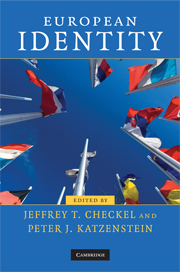Book contents
- Frontmatter
- Contents
- List of figures
- List of tables
- List of contributors
- Preface
- 1 The politicization of European identities
- Part I European identity as project
- 2 Political identity in a community of strangers
- 3 Experimental identities (after Maastricht)
- 4 The public sphere and the European Union's political identity
- Part II European identity as process
- Part III European identity in context
- Bibliography
- Index
2 - Political identity in a community of strangers
Published online by Cambridge University Press: 05 June 2012
- Frontmatter
- Contents
- List of figures
- List of tables
- List of contributors
- Preface
- 1 The politicization of European identities
- Part I European identity as project
- 2 Political identity in a community of strangers
- 3 Experimental identities (after Maastricht)
- 4 The public sphere and the European Union's political identity
- Part II European identity as process
- Part III European identity in context
- Bibliography
- Index
Summary
In this chapter I argue that the construction of European political identity does not necessarily rest on a definite conception of what it is to be European. This is so for two reasons – one related to the transformation of the very conception of political identification with one's own community in modern societies, and the other to the mixed nature of the European Union as a multilevel polity comprising both intergovernmental and supranational levels of governance. Any normative discourse about political identity in Europe must accommodate these two realities.
Political identity is both a social and a historical construct. As a social construct, it reflects the institutional nature of the political community As a historical construct, its emergence and consolidation is bound up with historical contingencies and with the way in which competing narratives and ideologies shape the self-perceptions of the members of the community. As suggested in the introductory essay to this volume, Europe's identities exist in the plural; and so it is for the more specific sense of political identities.
But there is an important functional element to political identity, insofar as this plays an important role in sustaining citizens' allegiance and loyalty to their political community. In this respect, the different kinds of motivations and cultural and psychological constructions that make different people identify with a political community may be irrelevant, as long as political identity helps to bring the members of a community together.
- Type
- Chapter
- Information
- European Identity , pp. 29 - 51Publisher: Cambridge University PressPrint publication year: 2009
- 27
- Cited by



